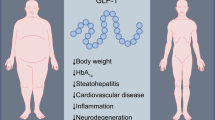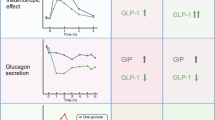Abstract
Progressive beta-cell insufficiency in the pancreas is a hallmark of both types I and II diabetes, and agents that protect against beta-cell dysfunction are potential drug targets for diabetes mellitus. Pituitary adenylate cyclase-activating polypeptide (PACAP) is a strong secretagogue of insulin from pancreatic islets and is suggested to be involved in physiological blood glucose homeostasis and the pathology of diabetes. Recent studies in genetically engineered animal models have shown that PACAP stimulates pancreatic functions, especially in cooperation with other regulatory factors including glucose. Furthermore, chronic activation of PACAP signaling regulates pancreatic islet mass in a context-dependent manner. Accumulating in vivo and in vitro evidence suggest that PACAP has trophic effects and regulates both proliferation and cell viability of beta-cells and thereby contributes to protection against diabetes. This review focuses on such trophic actions of PACAP on pancreatic beta-cells and discusses the pathophysiological significance of pancreatic PACAP, with the aim to provide information for future development of treatment for diabetes.

Similar content being viewed by others
References
Ahrén B (2008) Role of pituitary adenylate cyclase-activating polypeptide in the pancreatic endocrine system. Ann NY Acad Sci 1144:28–35
Borboni P, Porzio O, Pierucci D et al (1999) Molecular and functional characterization of pituitary adenylate cyclase-activating polypeptide (PACAP-38)/vasoactive intestinal polypeptide receptors in pancreatic beta-cells and effects of PACAP-38 on components of the insulin secretory system. Endocrinology 140:5530–5537
Broca C, Quoyer J, Costes S et al (2009) beta-Arrestin 1 is required for PAC1 receptor-mediated potentiation of long-lasting ERK1/2 activation by glucose in pancreatic beta-cells. J Biol Chem 284:4332–4342
Buscail L, Gourlet P, Cauvin A et al (1990) Presence of highly selective receptors for PACAP (pituitary adenylate cyclase activating peptide) in membranes from the rat pancreatic acinar cell line AR 4-2J. FEBS Lett 262:77–81
Eizirik D, Mandrup-Poulsen T (2001) A choice of death–the signal-transduction of immune-mediated beta-cell apoptosis. Diabetologia 44:2115–2133
Filipsson K, Ahrén B (1998) Protein kinase A inhibition and PACAP-induced insulin secretion in HIT-T15 cells. Ann NY Acad Sci 865:441–444
Filipsson K, Kvist-Reimer M, Ahrén B (2001) The neuropeptide pituitary adenylate cyclase-activating polypeptide and islet function. Diabetes 50:1959–1969
Fridolf T, Sundler F, Ahrén B (1992) Pituitary adenylate cyclase-activating polypeptide (PACAP): occurrence in rodent pancreas and effects on insulin and glucagon secretion in the mouse. Cell Tissue Res 269:275–279
Green B, Irwin N, Cassidy R, Gault V, Flatt P (2006) Long-term administration of PACAP receptor antagonist, PACAP(6-27), impairs glucose tolerance and insulin sensitivity in obese diabetic ob/ob mice. Peptides 27:2343–2349
Hamagami K, Sakurai Y, Shintani N et al (2009) Over-expression of pancreatic pituitary adenylate cyclase-activating polypeptide (PACAP) aggravates cerulein-induced acute pancreatitis in mice. J Pharmacol Sci 110:451–458
Han B, Wu J (2009) DcR3 protects islet beta cells from apoptosis through modulating Adcyap1 and Bank1 expression. J Immunol 183:8157–8166
Hashimoto H, Shintani N, Tanaka K et al (2001) Altered psychomotor behaviors in mice lacking pituitary adenylate cyclase-activating polypeptide (PACAP). Proc Natl Acad Sci USA 98:13355–13360
Inagaki N, Yoshida H, Mizuta M et al (1994) Cloning and functional characterization of a third pituitary adenylate cyclase-activating polypeptide receptor subtype expressed in insulin-secreting cells. Proc Natl Acad Sci USA 91:2679–2683
Kashimura J, Shimosegawa T, Kikuchi Y, Koizumi M, Toyota T (1991) The stimulatory effect of PACAP 38 on amylase release in dispersed rat pancreatic acini. Tohoku J Exp Med 164:309–318
Kawai K, Ohse C, Watanabe Y, Suzuki S, Yamashita K, Ohashi S (1992) Pituitary adenylate cyclase activating polypeptide stimulates insulin release from the isolated perfused rat pancreas. Life Sci 50:257–261
Köves K, Arimura A, Vigh S et al (1993) Immunohistochemical localization of PACAP in the ovine digestive system. Peptides 14:449–455
Lenzen S, Drinkgern J, Tiedge M (1996) Low antioxidant enzyme gene expression in pancreatic islets compared with various other mouse tissues. Free Radic Biol Med 20:463–466
Mathis D, Vence L, Benoist C (2001) beta-Cell death during progression to diabetes. Nature 414:792–798
Miyata A, Arimura A, Dahl RR et al (1989) Isolation of a novel 38 residue-hypothalamic polypeptide which stimulates adenylate cyclase in pituitary cells. Biochem Biophys Res Commun 164:567–574
Movassat J, Saulnier C, Portha B (1997) Insulin administration enhances growth of the beta-cell mass in streptozotocin-treated newborn rats. Diabetes 46:1445–1452
Nakata M, Shintani N, Hashimoto H, Baba A, Yada T (2010) Intra-islet PACAP protects pancreatic beta-cells against glucotoxicity and lipotoxicity. J Mol Neurosci, in press
Onoue S, Hanato J, Yamada S (2008) Pituitary adenylate cyclase-activating polypeptide attenuates streptozotocin-induced apoptotic death of RIN-m5F cells through regulation of Bcl-2 family protein mRNA expression. FEBS J 275:5542–5551
Portela-Gomes G, Lukinius A, Ljungberg O, Efendic S, Ahrén B, Abdel-Halim S (2003) PACAP is expressed in secretory granules of insulin and glucagon cells in human and rodent pancreas. Evidence for generation of cAMP compartments uncoupled from hormone release in diabetic islets. Regul Pept 113:31–39
Rhodes C (2005) Type 2 diabetes-a matter of beta-cell life and death? Science 307:380–384
Robertson R, Harmon J (2006) Diabetes, glucose toxicity, and oxidative stress: a case of double jeopardy for the pancreatic islet beta cell. Free Radic Biol Med 41:177–184
Sakurai Y, Shintani N, Arimori A et al (2010) Cerulein-induced acute pancreatitis in PACAP knockout mice. J Mol Neurosci, in press
Shintani N, Tomimoto S, Hashimoto H et al (2004) Functional roles of the neuropeptide PACAP in brain and pancreas. Life Sci 74:337–343
Thomas H, Biden T (2009) Bad news for beta-cell apoptosis. Diabetes 58:1725–1727
Tomimoto S, Hashimoto H, Shintani N et al (2004) Overexpression of pituitary adenylate cyclase-activating polypeptide in islets inhibits hyperinsulinemia and islet hyperplasia in agouti yellow mice. J Pharmacol Exp Ther 309:796–803
Tomimoto S, Ojika T, Shintani N et al (2008) Markedly reduced white adipose tissue and increased insulin sensitivity in adcyap1-deficient mice. J Pharmacol Sci 107:41–48
Tsunekawa S, Miura Y, Yamamoto N et al (2005) Systemic administration of pituitary adenylate cyclase-activating polypeptide maintains beta-cell mass and retards onset of hyperglycaemia in beta-cell-specific calmodulin-overexpressing transgenic mice. Eur J Endocrinol 152:805–811
Vaudry D, Falluel-Morel A, Bourgault S et al (2009) Pituitary adenylate cyclase-activating polypeptide and its receptors: 20 years after the discovery. Pharmacol Rev 61:283–357
Winzell MS, Ahrén B (2007) Role of VIP and PACAP in islet function. Peptides 28:1805–1813
Yada T, Sakurada M, Ihida K et al (1994) Pituitary adenylate cyclase activating polypeptide is an extraordinarily potent intra-pancreatic regulator of insulin secretion from islet beta-cells. J Biol Chem 269:1290–1293
Yada T, Sakurada M, Ishihara H et al (1997) Pituitary adenylate cyclase-activating polypeptide (PACAP) is an islet substance serving as an intra-islet amplifier of glucose-induced insulin secretion in rats. J Physiol 505:319–328
Yada T, Sakurada M, Filipsson K, Kikuchi M, Ahrén B (2000) Intraperitoneal PACAP administration decreases blood glucose in GK rats, and in normal and high fat diet mice. Ann NY Acad Sci 921:259–263
Yamada H, Watanabe M, Yada T (2004) Cytosolic Ca2+ responses to sub-picomolar and nanomolar PACAP in pancreatic β-cells are mediated by VPAC2 and PAC1 receptors. Regul Pept 123:147–153
Yamamoto K, Hashimoto H, Tomimoto S et al (2003) Overexpression of PACAP in transgenic mouse pancreatic beta-cells enhances insulin secretion and ameliorates streptozotocin-induced diabetes. Diabetes 52:1155–1162
Acknowledgments
Research was supported in part by Grants-in-Aid for Scientific Research (A) and (B) and for Young Scientists (B) from the Japan Society for the Promotion of Science.
Author information
Authors and Affiliations
Corresponding author
Rights and permissions
About this article
Cite this article
Sakurai, Y., Shintani, N., Hayata, A. et al. Trophic Effects of PACAP on Pancreatic Islets: A Mini-Review. J Mol Neurosci 43, 3–7 (2011). https://doi.org/10.1007/s12031-010-9424-z
Received:
Accepted:
Published:
Issue Date:
DOI: https://doi.org/10.1007/s12031-010-9424-z




